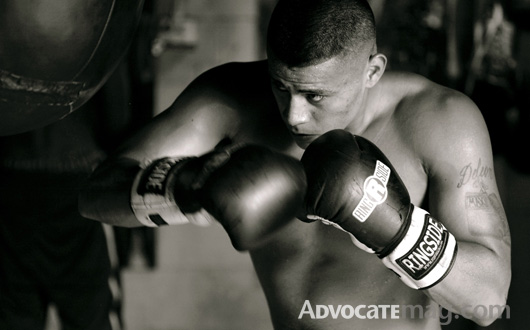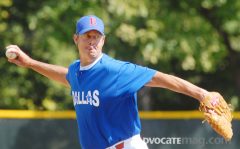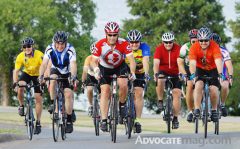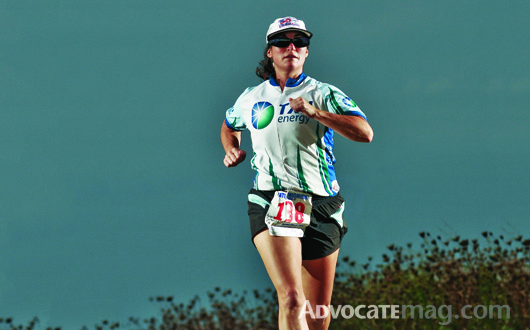Early-morning jogs, strict diets and punishing workouts are par for the course when you are a professional athlete. But what about the attorney, salesman or student who has a relentless passion for a particular sport? We’re not talking about your typical weekend warrior, but the hard-core athlete driven by something deeper than a desire to have fun or shed pounds.
Tortorice, not the hare
Angela Tortorice is a 42-year-old accountant who lives in Lakewood. But the woman is a maniac.
This year, she ran three marathons in three consecutive days. She has run 10 “doubles” — that’s two marathons in two consecutive days — and one 50-mile race.
She has completed marathons in all 50 states, and now she’s working on repeating that feat.
She’s part of a club called the Marathon Maniacs, whose tongue-in-cheek website, marathonmaniacs.com, features a delirious cartoon runner crossing a finish line. Club members can reach 10 levels, starting at “bronze”, and Tortorice is 10th-level “titanium”.
That means, among other criteria, that she ran 52 marathons in 365 days.
“I don’t necessarily think I’m good at running,” she says. “I’m good at endurance.”
The key, Tortorice says, is staying slow and steady. Her typical marathon time is 5:15. On her best days, she clocks in at just under five hours. That’s somewhere between 11 and 12 minutes per mile.
Tortorice’s running habit started 15 years ago, when she was 26 and a little out of shape. She started just to lose weight and feel better, and she ran her first marathon, in San Antonio, in 1997.
“Running gives you time to clear your head. It helps you cope with stress a lot better,” she says. “I run sometimes at lunchtime to relieve stress, and it just makes you feel better about yourself.”
Once she completes the 50 states a second time, Tortorice intends to train for the Holy Grail of marathons.
“It’s going to be hard because I am not fast,” she says. “But I would like to qualify for the Boston Marathon.”
In three years, when she turns 45, she’ll be in a new age class, for which the qualifying time is about four hours. Her personal best, from when she was a non-maniacal marathoner some 10 years ago, was about 3:56, so she’s sure she can do it. No doubt.
‘A student of the game’
 Max DeLeon of Old East Dallas has been knocked down. But he gets right back up.
Max DeLeon of Old East Dallas has been knocked down. But he gets right back up.
The 20-year-old has been boxing since he was 13, and in more than 40 fights, he has never been knocked out.
DeLeon played varsity football at Woodrow Wilson High School and graduated in 2009. He won a silver medal in the National Junior Olympics and a couple of Dallas Golden Gloves titles before heading to college at Stephen F. Austin State University.
He quit boxing for about a year and a half, but he started training again — six days a week for two-and-a-half hours — in May. Now an architecture major at the University of Texas at Arlington, he aims to go pro.
“He picks up everything, and he does what you ask him to do,” says Gene Vivero of Vivero Boxing Gym in Oak Cliff, where DeLeon trains.
Most talented boxers are men between the ages of 18 and 25, and some of them have bricks for brains. But not DeLeon.
“He’s a student of the game, and he listens,” Vivero says.
DeLeon sports a tattoo of boxing gloves on his left biceps with his name, “MAX”, where the logo “Everlast” would be. Above the gloves, in script, it reads “Deleon”.
DeLeon’s dad was a boxer, and he used to bring Max to the boxing gym when he was a kid.
“It’s addictive,” DeLeon says of the sport. “The adrenaline in the ring … it’s like it was just meant for me.”
Most boxers who turn pro never make much money at it. And DeLeon says he doesn’t have millionaire dreams. He’d like to make enough money at boxing to pay for college. His goal is to graduate with honors.
“There’s always going to be someone bigger and better than you in boxing,” he says. “If you get a college education, nobody’s going to take that away from you.”
Playing hardball
 Rick Burish of Lakewood has always been an all-star pitcher, and at 44, he’s reviving his glory days and leading his amateur baseball team to the September playoffs. But this is no intramural sport.
Rick Burish of Lakewood has always been an all-star pitcher, and at 44, he’s reviving his glory days and leading his amateur baseball team to the September playoffs. But this is no intramural sport.
“We’re not playing softball here,” he says. “It’s hardball.”
The Dallas Blue Stars of the North Texas Amateur Baseball League has been the first-place team in its division for much of the summer. The team plays at 9 p.m. every Sunday and Tuesday. Games can last until almost midnight and even later for Burish, who simply can’t turn off after throwing fastballs in the summer heat all evening.
“My arm is all wound up,” he says. “I can’t sleep for hours.”
But he still must crawl into the office the next morning at Quova, where he works in data sales.
“You just grab a bunch of coffee and power through it. My mind still thinks I’m 25.”
Burish hadn’t played ball since college when he joined the local league five years ago. He tried out, and it all came rushing back. So far, Burish has been named an all-star and won the league’s Bobby Newton Pitching Award.
“It was kind of like a riding a bike. You’ve got to be one of the best. Pitching is always a premium. It’s a super-competitive league. It’s a lot more fun to win than lose.”
The ‘Righteous Riders’
 Every Saturday, Scott Ellison of Lakewood gets up early and straps on some Spandex.
Every Saturday, Scott Ellison of Lakewood gets up early and straps on some Spandex.
By 7:30 a.m., he is at White Rock Lake with his friends, embarking on a bike ride that’s usually somewhere between 45 and 65 miles.
Hardly a day goes by that Ellison isn’t in the saddle at some point, putting in at least 15 or 20 miles.
It’s not that his habit is unusual. Ellison is a serious athlete, to be sure, but he is one of hundreds of Dallas cyclists whose home base is White Rock Lake. As a neighborhood resident, however, he and the rest of his cycling club — a group of guys in their 30s to 60s called the “righteous riders” — think of themselves as stewards of safety around the lake and on the road.
When the new Spillway design was completed, for example, there was a new curb at the end of a trail, and it hadn’t been there before. A friend came screaming down the path one night, hit the unmarked curb and flew over his handlebars.
The next day, Ellison called councilman Sheffie Kadane to notify him of the dangerous new curb. And the same day, Dallas Park and Recreation workers marked the curb with reflective paint.
One thing that’s galling, he says, is the number of cyclists he sees riding without helmets. Ellison always has been serious about helmets because of a close call.
One summer, as a kid growing up in Nebraska, he fell off his skateboard and hit his head on the curb. He called his mom at work to tell her, and she said, “You’re fine.”
That night, he and his friends decided to play football in the backyard. When he came back in, he pulled off his football helmet, “and there was this big ball of Jell-O where I had hit my head.”
He had broken two blood vessels on his head — luckily, on the outside of his skull.
“Otherwise, I probably would’ve died,” he says.
Ellison refers to the helmetless riders as “organ donors”, and he and his friends make sure to obey all traffic laws while they ride. They stop at stop signs and don’t ride faster than the 20 mile-per-hour speed limit for cyclists at the lake.
“There are some people who give cyclists a bad name, but by and large, most of them are pretty good,” he says. “In the same vein, there are a lot of people driving on Lawther who get upset with cyclists because they’re not going fast enough for them.”
Just as cyclists should ride safely, drivers should remember they’re traveling through a park, he says. And runners should remember that they’re sharing the road with bikes and cars.
“Everybody’s guilty in some way,” he says.






